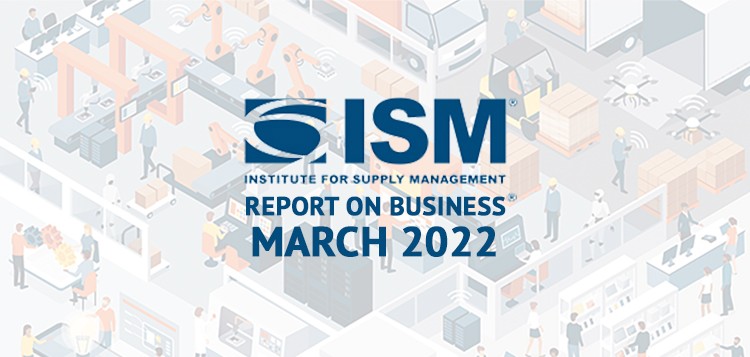March 2022 Manufacturing ISM Report On Business Remains Stable As Prices Skyrocket

As we close the door on the first quarter, the second quarter opens with the March 2022 Manufacturing ISM Report On Business. At first glance, March’s report shows a relatively stable manufacturing economy.
Total Purchasing Managers Index (PMI) shed 1.5 points in March to remain stable at 57.1, but there was more than a little volatility across the aggregate metrics used to determine PMI. With more than half of the 10 composite metrics shifting by 3 percentage points or more in March, the report echoes concerns expressed by industry executives heading into the second quarter.
Breaking down the report
The March report was fraught with volatility. On the negative end of the spectrum, New Orders dropped by 7.9 points, followed by a drop of 4 points in Production figures. The Backlog of Orders Index also shaved off 5 points for the month. Both Import and Export figures were down, 3.6 and 3.9 points, respectively.
The bright spot of the report was a 3.4-point rise in employment figures. Inventories and Customers’ Inventories were also up 1.9 and 2.3 points, respectively. No new trends developed in March, but import-export is trending toward contraction territory as global trade suffers.

Skyrocketing prices are cause for alarm
The standout metric from March’s report was the explosive 11.5-point increase in Prices, which ticked up at the highest month-over-month rate since December 2020. Raw materials — particularly those used in fabrication and construction — are creating trepidation among industry executives. According to one machinery respondent, “Prices are increasing on steel and steel products after a slight decrease from highs last month. Transportation costs are going up significantly with the increase in fuel prices.”
All 18 industries reported significant inflation in material prices. The spike is attributed to several global events, including supply chain disruption caused by ongoing conflict in Ukraine. A fresh wave of COVID-19 outbreaks in China has also added significant cost and delays for materials, including aluminum, nickel, copper, and other metals.
Semiconductor concerns persist
Raw materials aren’t the only commodities in high demand and short supply. The global semiconductor crisis continues to trouble many industries. From automotive to aerospace, and numerous industries in between, low availability is putting significant strain on producers of key goods. Industry executives don’t see any reprieve in sight. As one computer and electronic products respondent said, “No letup yet in supply chain challenges, especially electronic components. Relying more and more on the broker market.”
Economists expect delays to get worse in 2022, as neon gas exports from Ukraine and palladium from Russia strain an already tenuous semiconductor manufacturing bottleneck. At the end of March, expected delays for semiconductors rose to more than 26 weeks, with even longer lead times expected by the end of the second quarter.

Today’s stability could be tomorrow’s volatility
Despite several monumental struggles, the March 2022 PMI fell just 1.5 points in total, signaling relative strength from the industry as major manufacturers stand ready to adapt. Unfortunately, economists predict sky-high prices, semiconductor shortages, and similar problems to persist far into 2022, which means little relief in sight for supply-side pressures. It’s all manufacturers can do to execute evasive maneuvers now and prepare for more hardship to come.
